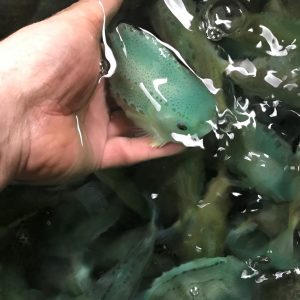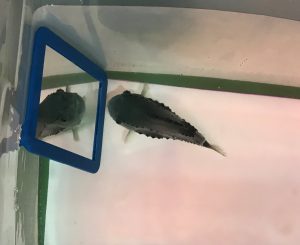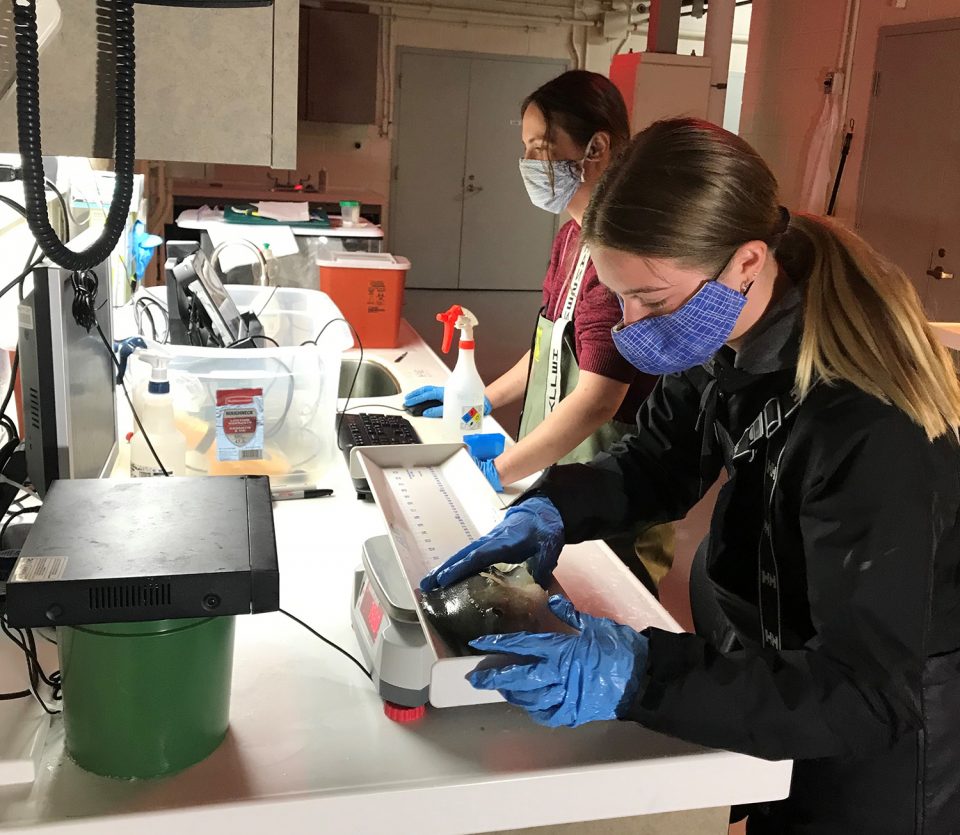Knowing a bit of fish psychology might be key to the future success and health of aquaculture

Like a human, a fish can exhibit certain behavioral traits – they have a personality, if you will. Some are shy and submissive, while others are bold and even aggressive. Now, a consortium of partners in Scotland is investigating whether the behavior of ballan wrasse (Labrus bergylta) makes this species more adept at removing sea lice from salmon farms, a duty that earns them and several others the moniker “cleaner fish.” The team – comprising the University of Stirling’s Institute of Aquaculture, Loch Duart and Otter Ferry Seafish, with support from the Sustainable Aquaculture Innovation Centre (SAIC) – wants to find out how the species interact with one another and determine the optimal conditions for deploying them at sea.
Similar work is underway in Canada. Researchers at Fisheries and Oceans Canada’s (DFO) St. Andrew’s Biological Station are working with lumpfish (Cyclopterus lumpus) to investigate whether traits such as shyness or aggressiveness are inherited and, if so, whether they could be used as the basis for breeding programs.
“It is believed that some lumpfish don’t clean as actively as others,” DFO biologist Steve Leadbeater told the Advocate. “We wanted to find out why and whether a screening test could be developed to suggest which individuals would be more likely to be cleaners. We also wondered whether we could see a genetic relationship or trait that might suggest the type of cleaner a lumpfish might be, so that if and when a focused program on lumpfish breeding was developed, the genetic markers to look for would be available.”

Together with Cooke Aquaculture and Dr. Ben Whittaker and Professor Elizabeth Boulding of the University of Guelph, Leadbeater and his team profiled lumpfish personality by determining traits that are suggestive of curiosity and aggression. To assess behavior, they used a mirror test whereby individuals avoiding their reflection were deemed less social than others. The fish were also exposed to a novel object and monitored – those interacting more frequently with the object were considered bolder and more curious than those that didn’t, and therefore more likely to interact with salmon.
“Tests like these could determine which fish are likely to be better cleaners,” said Leadbeater. “We are now pairing lumpfish with salmon carrying sea lice and looking at the relationship between personality and the success of lumpfish in consuming sea lice. Our next step is to see how salmon respond to lumpfish. They may contain a trait that could help breed salmon that want to be cleaned.”
What drives fish behavior could increase productivity or result in more efficient fish farming and optimal conditions for fish health and well-being. Dr. Sonia Rey Planellas of the University of Stirling in Scotland believes that understanding fish behavior may allow researchers to establish genetic breeding lines with improved growth, survival and disease resistance. Together with her colleagues and the Institute for Food and Agricultural Research and Technology (IRTA) in Catalonia, Rey Planellas developed a series of tests to determine how Senegalese sole (Solea senegalensis) reacted to stress. Two mannerisms were found.
“Reactive fish are shy, non-aggressive individuals with more exploratory behavior. Proactive fish are mainly bold, more dominant and usually aggressive individuals that display more routine-like behavioral patterns and take higher risks when faced with potential threats,” she said.

Rey Planellas believes that using selective breeding to encourage such behavioral traits could be a cheap and practical way to improve fish health and increase reproductivity on farms.
“We wanted to characterize the stress coping styles of Senegalese sole and establish an operational behavioral screen test (OBST) for farmers to classify and select behavioral characteristics that may be advantageous to reproductive fitness, or be used in selection-based breeding programs to improve domestication and produce fingerlings with specific behavioral traits,” said Rey Planellas. “OBSTs can be performed quickly with relatively few modifications to rearing environment.”
“They could offer valuable information, for example how efficiently fish can adapt to rearing conditions and husbandry,” she continued. “We tested zebrafish followed by carp. Although these tests were done experimentally and not in aquaculture production, they can be used in all growth stages of species such as sea bass, sea bream and tilapia.”
https://www.aquaculturealliance.org/advocate/farmers-deploy-new-high-tech-tools-against-sea-lice/
Behavioral responses are the first defense that fish have against stressful situations such as environmental changes or encountering predators but reactions can vary. In this sense, it is hard to say whether coping styles are heritable, said Dr. Johan Schrama of Wageningen University in the Netherlands. Schrama and his team have studied the relationship between feed intake, growth rate and behavior in sole (Solea solea).
“Some characteristics like aggressiveness or feeding behavior might be heritable but I’m unsure whether stress-coping styles are, because there are collections of traits in fish that could result in a particular response,” said Schrama. “The amount of feed they consume, the nutrients they have absorbed and other factors such as environment, water quality parameters or stocking density can all have an impact but in ways that are difficult to predict. Coping styles are not fixed. There is flexibility in that an individual could move from one style to another at a certain moment.”
However, Schrama found that individual differences in feeding consistency, swimming activity and behavioral reactions under challenging situations, such as a novel environment or increased light intensity, did explain variations in feed intake and growth. Proactive fish had a more successful feeding strategy in captivity, displaying higher feed intake and growth, so behavioral traits may be of interest during selection in breeding programs.
“I agree with Dr. Schrama that there is an epigenetic component and flexibility in fish behavior and it is difficult to select for all the traits related to coping styles,” said Rey Planellas. “Different species can be intrinsically more or less proactive or reactive. They also have circadian rhythms and preferences for different parameters. But behavior can shed light on a fish’s internal state, which helps to tailor its rearing environment. This has a big impact on improving fish welfare, which, after all, is an evaluation of a fish’s internal state.”
However, Rey Planellas points out that it’s not altogether common to select for behavioral traits, and there is still much to learn.
“Aquaculture selects traits such as high growth rate or disease resistance rather than behavior,” she said. “However, when you select high growth rate, for example, you are also indirectly selecting bolder, aggressive fish. But in some species, you may not necessarily want those traits. Bolder fish have more routine-like behavior so when environmental conditions change, they may have less resilient responses and die. Fish are very flexible so there is still a need to be careful.”
Follow the Advocate on Twitter @GAA_Advocate
Now that you've finished reading the article ...
… we hope you’ll consider supporting our mission to document the evolution of the global aquaculture industry and share our vast network of contributors’ expansive knowledge every week.
By becoming a Global Seafood Alliance member, you’re ensuring that all of the pre-competitive work we do through member benefits, resources and events can continue. Individual membership costs just $50 a year. GSA individual and corporate members receive complimentary access to a series of GOAL virtual events beginning in April. Join now.
Not a GSA member? Join us.
Author
-

Bonnie Waycott
Correspondent Bonnie Waycott became interested in marine life after learning to snorkel on the Sea of Japan coast near her mother’s hometown. She specializes in aquaculture and fisheries with a particular focus on Japan, and has a keen interest in Tohoku’s aquaculture recovery following the 2011 Great East Japan Earthquake and Tsunami.

